2016 MERCEDES-BENZ GLE lane assist
[x] Cancel search: lane assistPage 262 of 450
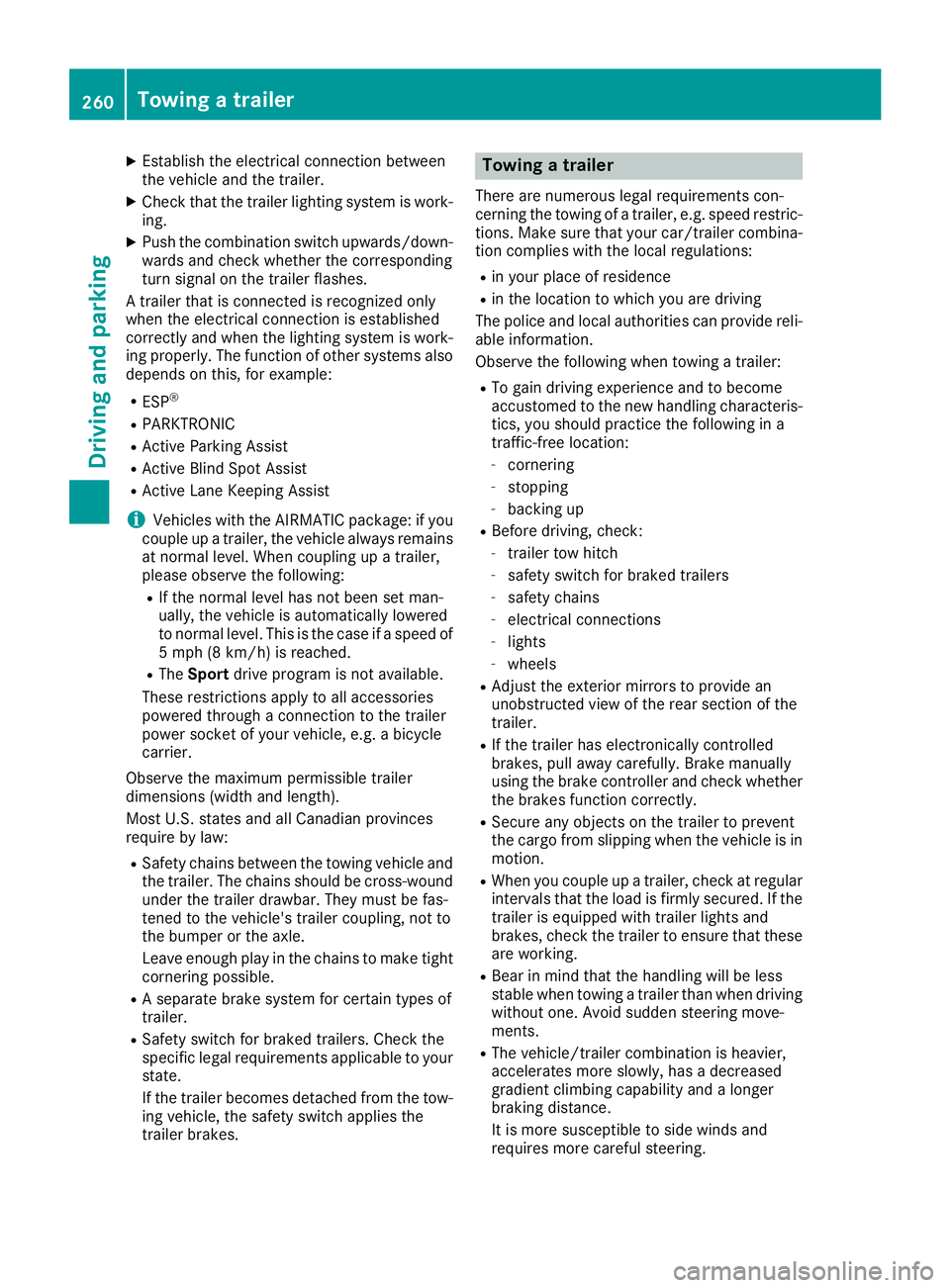
X
Establish the electrical connection between
the vehicle and the trailer. X
Check that the trailer lighting system is work-
ing. X
Push the combination switch upwards/down-
wards and check whether the corresponding
turn signal on the trailer flashes.
A trailer that is connected is recognized only
when the electrical connection is established
correctly and when the lighting system is work-
ing properly. The function of other systems also
depends on this, for example: R
ESP ®
R
PARKTRONIC R
Active Parking Assist R
Active Blind Spot Assist R
Active Lane Keeping Assist
i Vehicles with the AIRMATIC package: if you
couple up a trailer, the vehicle always remains
at normal level. When coupling up a trailer,
please observe the following: R
If the normal level has not been set man-
ually, the vehicle is automatically lowered
to normal level. This is the case if a speed of
5 mph (8 km/h) is reached. R
The Sport drive program is not available.
These restrictions apply to all accessories
powered through a connection to the trailer
power socket of your vehicle, e.g. a bicycle
carrier.
Observe the maximum permissible trailer
dimensions (width and leng th).
M ost U.S. states and all Canadian provinces
require by law: R
Safety chains between the towing vehicle and
the trailer. The chains should be cross-wound
under the trailer drawbar. They must be fas-
tened to the vehicle's trailer coupling, not to
the bumper or the axle.
Leave enough play in the chains to make tight
cornering possible. R
A separate brake system for certain types of
trailer. R
Safety switch for braked trailers. Check the
specific legal requirements applicable to your
state.
If the trailer becomes detached from the tow-
ing vehicle, the safety switch applies the
trailer brakes. Towing a trailer There are numerous legal requirements con-
cerning the towing of a trailer, e.g. speed restric-
tions. Make sure that your car/trailer combina-
tion complies with the local regulations: R
in your place of residence R
in the location to which you are driving
The police and local authorities can provide reli-
able information.
Observe the following when towing a trailer: R
To gain driving experience and to become
accustomed to the new handling characteris-
tics, you should practice the following in a
traffic-free location: -
cornering -
stopping -
backing up R
Before driving, check: -
trailer tow hitch -
safety switch for braked trailers -
safety chains -
electrical connections -
lights -
wheels R
Adjust the exterior mirrors to provide an
unobstructed view of the rear section of the
trailer. R
If the trailer has electronically controlled
brakes, pull away carefully. Brake manually
using the brake controller and check whether
the brakes function correctly. R
Secure any objects on the trailer to prevent
the cargo from slipping when the vehicle is in
motion. R
When you couple up a trailer, check at regular
intervals that the load is firmly secured. If the
tra i ler is equipped with trailer lights and
brakes, check the trailer to ensure that these
are working. R
Bear in mind that the handling will be less
stable when towing a trailer than when driving
without one. Avoid sudden steering move-
ments. R
The vehicle/trailer combination is heavier,
accelerates more slowly, has a decreased
gradient climbing capability and a longer
braking distance.
It is more susceptible to side winds and
requires more careful steering.260
Towing a trailer
Driving an d parking
Page 273 of 450
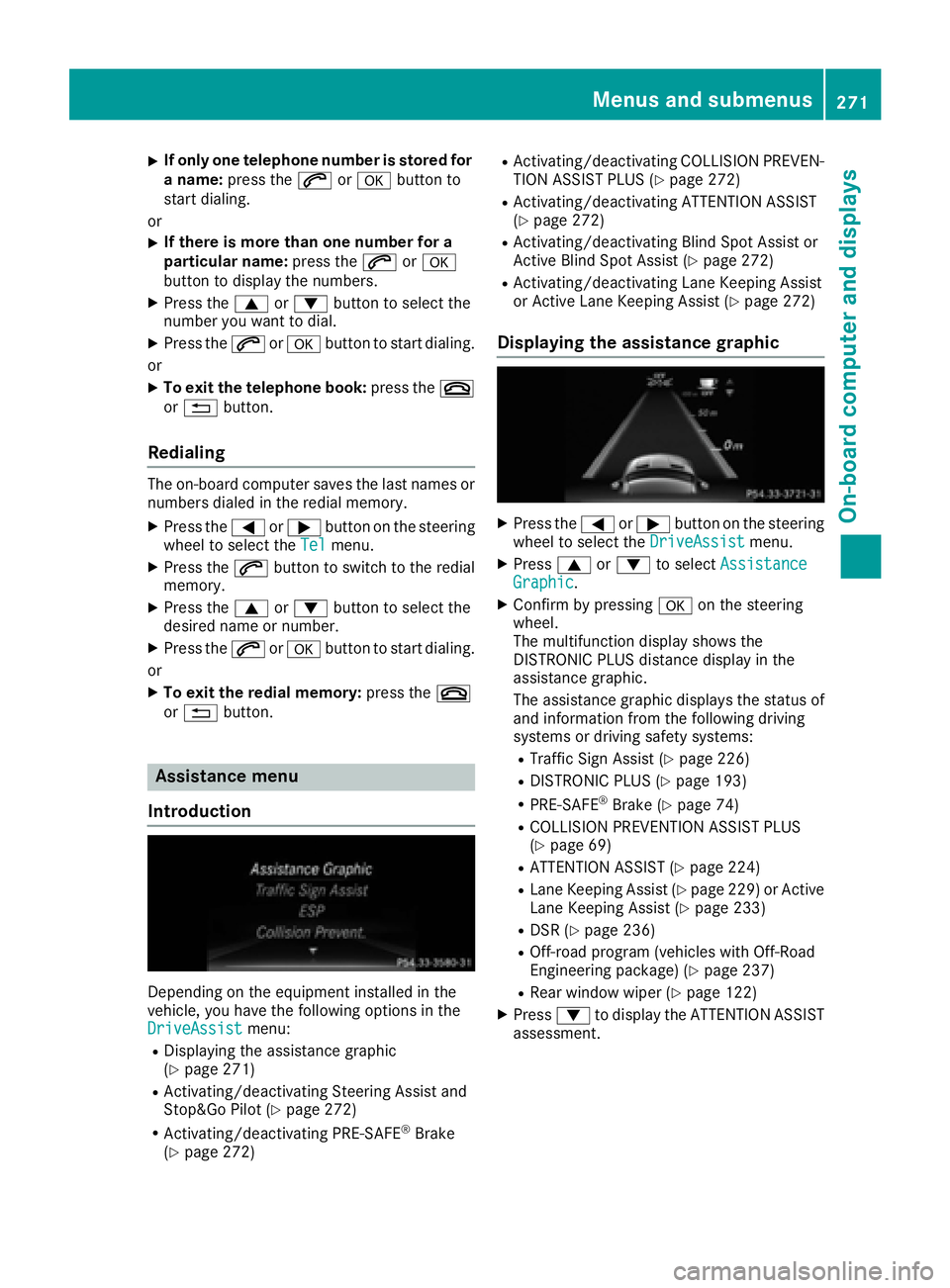
X
If only one telephone number is stored for
a name: press the �a or �v button to
start dialing.
or X
If there is more than one number for a
particular name: press the �a or �v
button to display the numbers. X
Press the �c or �d button to select the
number you want to dial. X
Press the �a or �v button to start dialing.
or X
To exit the telephone book: press the �v
or �8 button.
Redialing The on-board computer saves the last names or
numbers dialed in the redial memory. X
Press the �Y or �e button on the steering
wheel to select the Tel menu.X
Press the �a button to switch to the redial
memory. X
Press the �c or �d button to select the
desired name or number. X
Press the �a or �v button to start dialing.
or X
To exit the redial memory: press the �v
or �8 button.
Assistance menu
Introduction
Depending on the equipment installed in the
vehicle, you have the following options in the
DriveAssist menu:R
Displaying the assistance graphic
( Y
page 271) R
Activating/deactivating Steering Assist and
Stop&Go Pilot ( Y
page 272)R
Activating/deactivating PRE-SAFE ®
Brake
( Y
page 272) R
Activating/deactivating COLLISION PREVEN-
TION ASSIST PLUS ( Y
page 272)R
Activating/deactivating ATTENTION ASSIST
( Y
page 272) R
Activating/deactivating Blind Spot Assist or
Active Blind Spot Assist ( Y
page 272)R
Activating/deactivating Lane Keeping Assist
or Active Lane Keeping Assist ( Y
page 272)
Displaying the assistance graphic X
Press the �Y or �e button on the steering
wheel to select the DriveAssist menu.X
Press �c or �d to select Assistance
Graphic . X
Confirm by pressing �v on the steering
wheel.
The multifunction display shows the
DISTRONIC PLUS distance display in the
assistance graphic.
The assistance graphic displays the status of
and information from the following driving
systems or driving safety systems: R
Traffic Sign Assist ( Y
page 226)R
DISTRONIC PLUS ( Y
page 193)R
PRE-SAFE ®
Brake ( Y
page 74)R
COLLISION PREVENTION ASSIST PLUS
( Y
page 69) R
ATTENTION ASSIST ( Y
page 224)R
Lane Keeping Assist ( Y
page 229) or Active
Lane Keeping Assist ( Y
page 233)R
DSR ( Y
page 236) R
Off-road program (vehicles with Off-Road
Engineering package) ( Y
page 237)R
Rear window wiper ( Y
page 122)X
Press �d to display the ATTENTION ASSIST
assessment.Menus and submenus 271
On-board computer and displays Z
Page 275 of 450
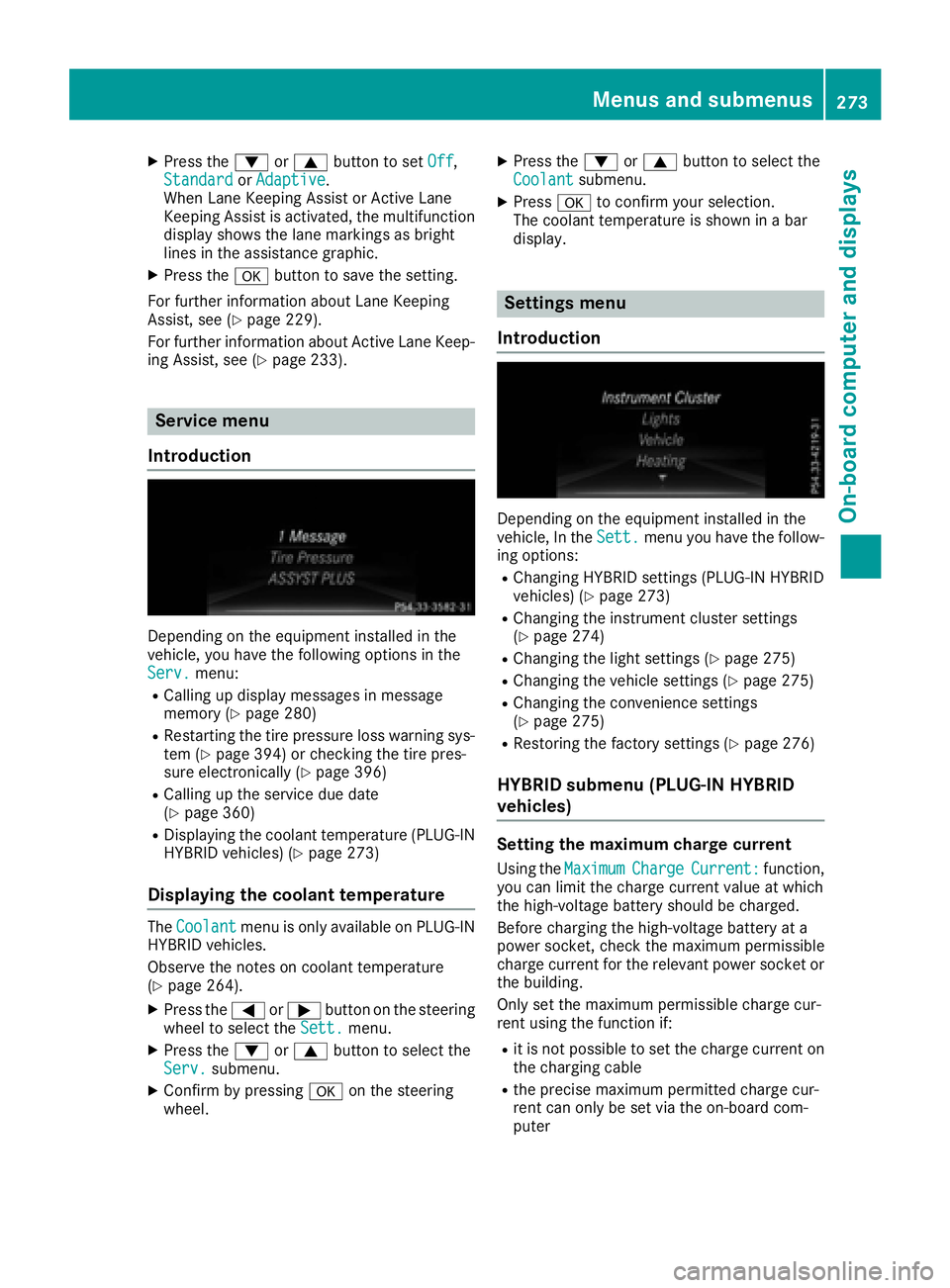
X
Press the �d or �c button to set Off ,
Standard or Adaptive .
When Lane Keeping Assist or Active Lane
Keeping Assist is activated, the multifunction
display shows the lane markings as bright
lines in the assistance graphic. X
Press the �v button to save the setting.
For further information about Lane Keeping
Assist, see ( Y
page 229).
For further information about Active Lane Keep-
ing Assist, see ( Y
page 233).
Service menu
Introduction
Depending on the equipment installed in the
vehicle, you have the following options in the
Serv. menu:R
Calling up display messages in message
memory ( Y
page 280)R
Restarting the tire pressure loss warning sys-
tem ( Y
page 394) or checking the tire pres-
sure electronically ( Y
page 396)R
Calling up the service due date
( Y
page 360) R
Displaying the coolant temperature (PLUG-IN
HYBRID vehicles) ( Y
page 273)
Displaying the coolant temperature The Coolant menu is only available on PLUG-IN
HYBRID vehicles.
Observe the notes on coolant temperature
( Y
page 264). X
Press the �Y or �e button on the steering
wheel to select the Sett. menu.X
Press the �d or �c button to select the
Serv. submenu.X
Confirm by pressing �v on the steering
wheel. X
Press the �d or �c button to select the
Coolant submenu. X
Press �v to confirm your selection.
The coolant temperature is shown in a bar
display.
Settings menu
Introduction
Depending on the equipment installed in the
vehicle, In the Sett. menu you have the follow-
ing options: R
Changing HYBRID settings (PLUG-IN HYBRID
vehicles) ( Y
page 273) R
Changing the instrument cluster settings
( Y
page 274) R
Changing the light settings ( Y
page 275)R
Changing the vehicle settings ( Y
page 275)R
Changing the convenience settings
( Y
page 275) R
Restoring the factory settings ( Y
page 276)
HYBRID submenu (PLUG-IN HYBRID
vehicles)
Setting the maximum charge current
Using the Maximum Charge Current: function,
you can limit the charge current value at which
the high-voltage battery should be charged.
Before charging the high-voltage battery at a
power socket, check the maximum permissible
charge current for the relevant power socket or
the building.
Only set the maximum permissible charge cur-
rent using the function if: R
it is not possible to set the charge current on
the charging cable R
the precise maximum permitted charge cur-
rent can only be set via the on-board com-
puterMenus and submenus 273
On-board computer and displays Z
Page 321 of 450
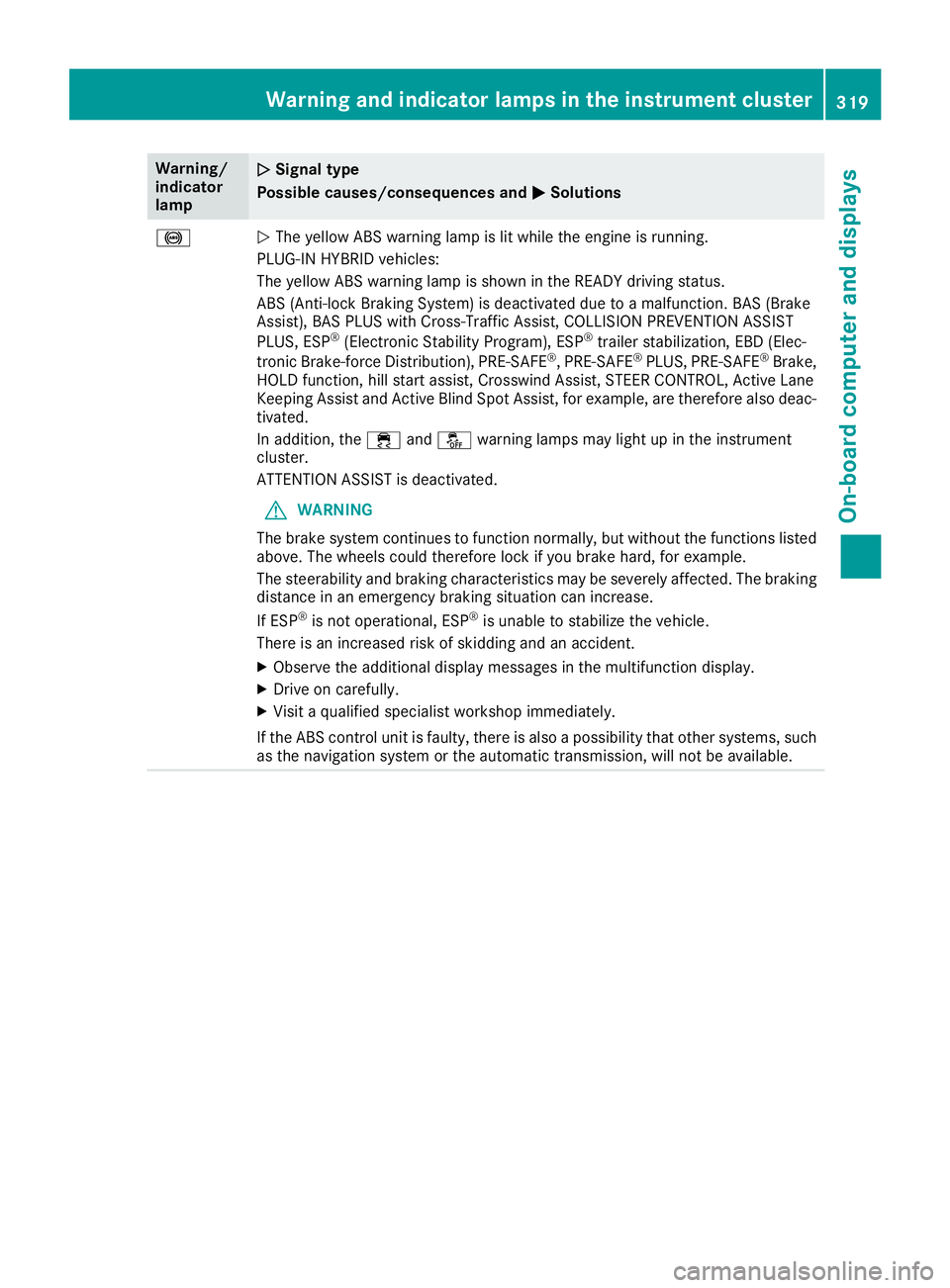
Warning/
indicator
lamp �Q Signal type
Possible causes/consequences and �P Solutions
�%
�Q The yellow ABS warning lamp is lit while the engine is running.
PLUG-IN HYBRID vehicles:
The yellow ABS warning lamp is shown in the READY driving status.
ABS (Anti-lock Braking System) is deactivated due to a malfunction. BAS (Brake
Assist), BAS PLUS with Cross-Traffic Assist, COLLISION PREVENTION ASSIST
PLUS, ESP ®
(Electronic Stability Program), ESP ®
trailer stabilization, EBD (Elec-
tronic Brake-force Distribution), PRE ‑ SAFE ®
, PRE ‑ SAFE ®
PLUS, PRE ‑ SAFE ®
Brake,
HOLD function, hill start assist, Crosswind Assist, STEER CONTROL, Active Lane
Keeping Assist and Active Blind Spot Assist, for example, are therefore also deac-
tivated.
In addition, the �
Page 322 of 450
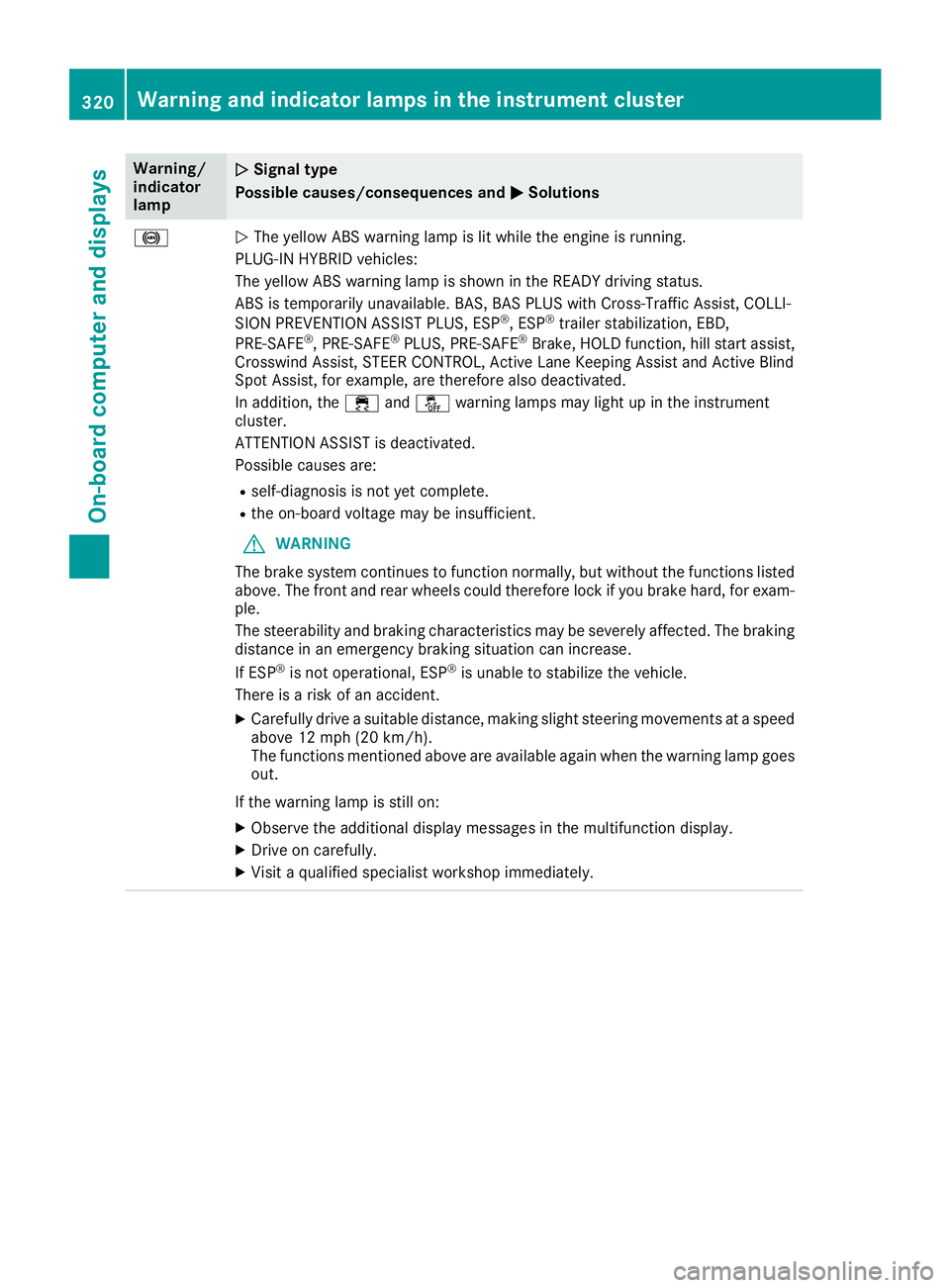
Warning/
indicator
lamp �Q Signal type
Possible causes/consequences and �P Solutions
�%
�Q The yellow ABS warning lamp is lit while the engine is running.
PLUG-IN HYBRID vehicles:
The yellow ABS warning lamp is shown in the READY driving status.
ABS is temporarily unavailable. BAS, BAS PLUS with Cross-Traffic Assist, COLLI-
SION PREVENTION ASSIST PLUS, ESP ®
, ESP ®
trailer stabilization, EBD,
PRE ‑ SAFE ®
, PRE ‑ SAFE ®
PLUS, PRE ‑ SAFE ®
Brake, HOLD function, hill start assist,
Crosswind Assist, STEER CONTROL, Active Lane Keeping Assist and Active Blind
Spot Assist, for example, are therefore also deactivated.
In addition, the �
Page 323 of 450
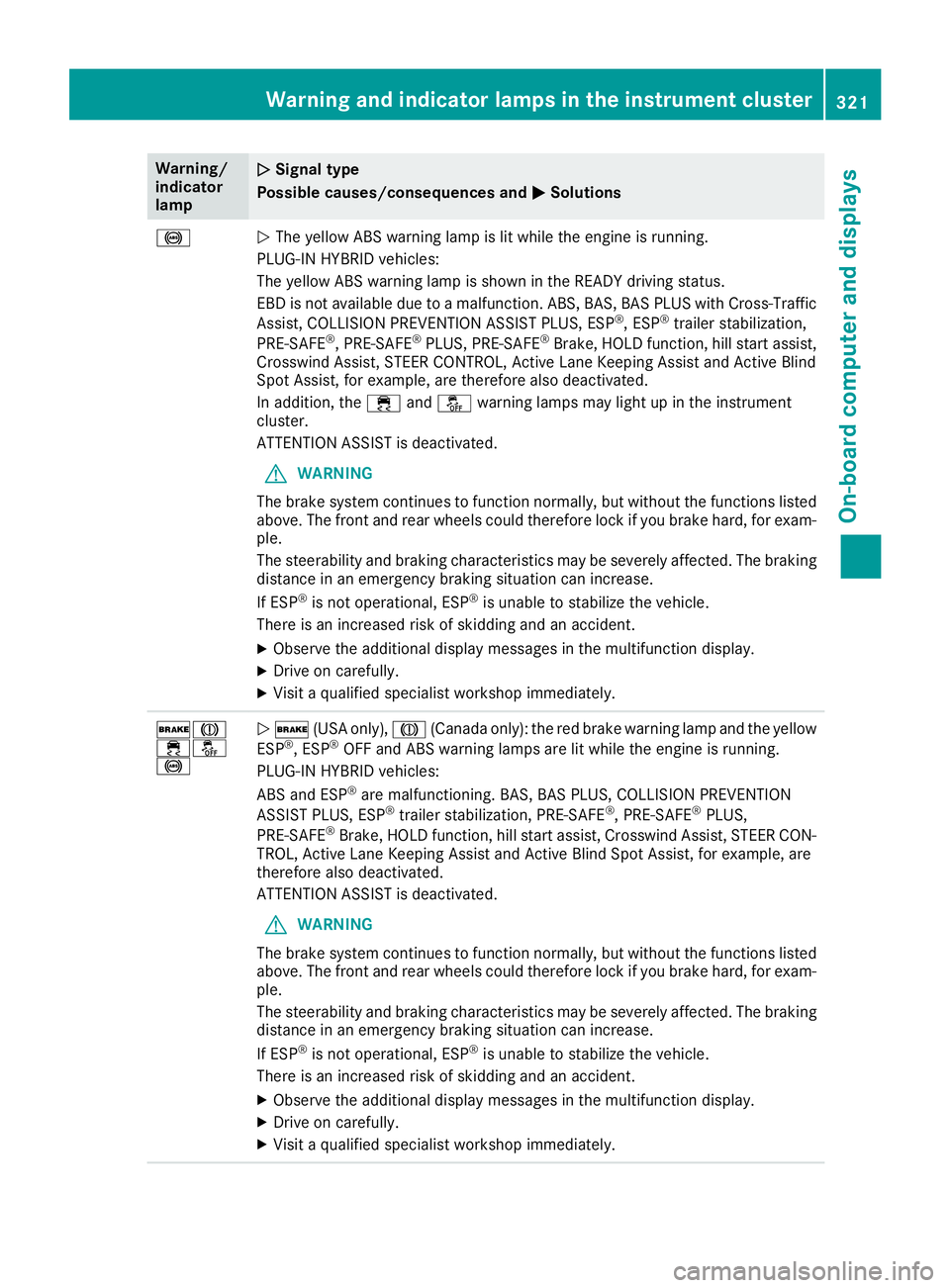
Warning/
indicator
lamp �Q Signal type
Possible causes/consequences and �P Solutions
�%
�Q The yellow ABS warning lamp is lit while the engine is running.
PLUG-IN HYBRID vehicles:
The yellow ABS warning lamp is shown in the READY driving status.
EBD is not available due to a malfunction. ABS, BAS, BAS PLUS with Cross-Traffic
Assist, COLLISION PREVENTION ASSIST PLUS, ESP ®
, ESP ®
trailer stabilization,
PRE ‑ SAFE ®
, PRE ‑ SAFE ®
PLUS, PRE ‑ SAFE ®
Brake, HOLD function, hill start assist,
Crosswind Assist, STEER CONTROL, Active Lane Keeping Assist and Active Blind
Spot Assist, for example, are therefore also deactivated.
In addition, the �